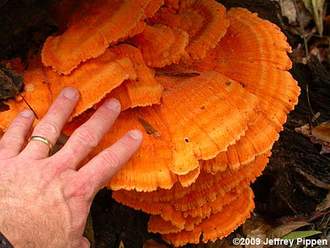- Home
- Mushrooms - why?
- Chaga mushroom - medicinal
- Red reishi - medicinal
- Chicken mushroom – food
- Puffballs - food
- Maitake mushroom - medicinal
- Chanterelle mushroom - food
- Lobster mushrooms - food
- Honey mushrooms -food
- Shiitake mushroom – medicinal and food
- Morels - food
- Oyster Mushrooms - medicinal and food
- Common poisonous mushrooms in NC
- How to grow oyster mushrooms at home
- Blog
Chicken Mushroom

Also called sulpher shelf
Suppose to taste like chickens but has no distinctive odor
The older mushrooms get bitter tasting so the young plumpy
feeling ones are best
This mushroom usually grows on or around oak trees. They range from bright yellow to reddish orange. They grow in a shelflike
formation with overlapping clusters and are stemless.
These mushrooms will first appear in late spring through early fall. Their scent is mild and
butterscotchy.
Ecology: Parasitic on living and dead oaks (also sometimes on the wood of other hardwoods); causing a reddish brown cubical heart rot, with thin areas of white mycelium visible in the cracks of the wood; annual; growing alone or, more typically, in large clusters; summer and fall, rarely in winter and spring; east of the Rocky Mountains. The mushrooms do not appear until well after the fungus has attacked
the tree.
Suppose to taste like chickens but has no distinctive odor
The older mushrooms get bitter tasting so the young plumpy
feeling ones are best
This mushroom usually grows on or around oak trees. They range from bright yellow to reddish orange. They grow in a shelflike
formation with overlapping clusters and are stemless.
These mushrooms will first appear in late spring through early fall. Their scent is mild and
butterscotchy.
Ecology: Parasitic on living and dead oaks (also sometimes on the wood of other hardwoods); causing a reddish brown cubical heart rot, with thin areas of white mycelium visible in the cracks of the wood; annual; growing alone or, more typically, in large clusters; summer and fall, rarely in winter and spring; east of the Rocky Mountains. The mushrooms do not appear until well after the fungus has attacked
the tree.
